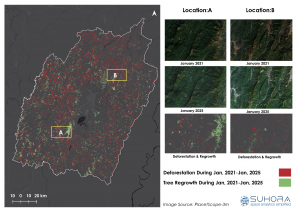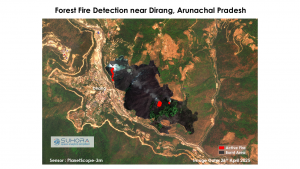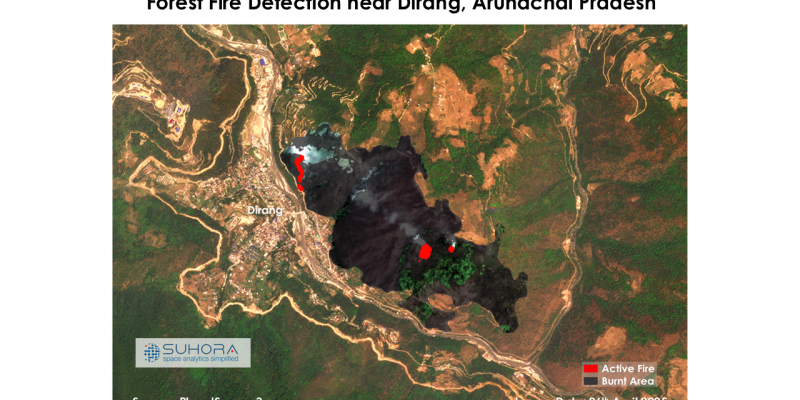World Environment Day: Suhora Releases Study on Deforestation in Manipur and Arunachal Forest Fire
On the occasion of World Environment Day, Suhora Technologies, a leading Earth observation and analytics company based in India specializing in downstream space analytics, today released a study highlighting the environmental challenges in the Northeast like Deforestation scenario in Manipur and Forrest Fire in Arunachal Pradesh.
Manipur Deforestation
 Manipur, a state celebrated for its rich forests and exceptional biodiversity, is facing mounting pressure from deforestation. According to Global Forest Watch, the state lost approximately 17.8 thousand hectares of natural forest in 2024 alone, leading to the release of nearly 9.11 million metric tons of CO₂ into the atmosphere. This alarming figure is part of a broader trend of forest decline that has persisted since 2001.
Manipur, a state celebrated for its rich forests and exceptional biodiversity, is facing mounting pressure from deforestation. According to Global Forest Watch, the state lost approximately 17.8 thousand hectares of natural forest in 2024 alone, leading to the release of nearly 9.11 million metric tons of CO₂ into the atmosphere. This alarming figure is part of a broader trend of forest decline that has persisted since 2001.
Bringing fresh insights into this issue, a comprehensive study conducted by SUHORA sheds light on the forest dynamics in Manipur between 2021 and 2025. The study found that approximately 21.1 thousand hectares of forest area was lost during this period due to a combination of anthropogenic and environmental factors. However, the findings also point to a hopeful sign of recovery—an estimated 13 hectares of land has experienced vegetation regrowth.
The drivers behind this forest loss are complex. Traditional shifting cultivation (jhum), which was once ecologically sustainable, has increasingly become detrimental due to shortened fallow cycles that hinder forest regeneration. This is compounded by illegal logging, fuelwood collection, and the proliferation of poppy cultivation, which has led to extensive forest clearing in remote hill areas.
Adding further stress are infrastructure development projects, including the construction of roads and railways. These developments, while critical to connectivity, not only causes deforestation but also elevate the risk of landslides in Manipur’s fragile hill ecosystems. Moreover, the impacts of climate change—increased temperature, altered rainfall patterns, and forest vulnerability to wildfires and pests—have made the situation more precarious.
Forest Fires in Arunachal Pradesh:
 A massive forest fire incident occurred in the Nadipar region near Dirang town, located in Arunachal Pradesh’s West Kameng district, starting on Thursday, April 24, 2025. Driven by strong winds, the blaze quickly spread through the Nadipar forest, scorching several acres of land and raising serious concerns about ecological damage. Fortunately, officials have confirmed that there were no human casualties or damage to property.
A massive forest fire incident occurred in the Nadipar region near Dirang town, located in Arunachal Pradesh’s West Kameng district, starting on Thursday, April 24, 2025. Driven by strong winds, the blaze quickly spread through the Nadipar forest, scorching several acres of land and raising serious concerns about ecological damage. Fortunately, officials have confirmed that there were no human casualties or damage to property.
The incident was promptly detected and analyzed by Suhora using advanced machine learning algorithms for fire detection, which leverages daily PlanetScope satellite imagery. Using imagery from April 26, 2025, Suhora successfully identified both the areas impacted by fire (covering 1.0895 square kilometers) and regions with active flames (covering 0.0326 square kilometers) using data from April 26, 2025. However, many forest fire incidents escape timely detection; may not be captured promptly, leading to severe environmental damage. With satellite intelligence solutions, such events can be detected early, enabling timely action and more effective control.
On its insights, Krishanu Acharya, CEO, Suhora Technologies, said, “Our planet faces a web of interconnected environmental threats from polluted rivers to raging forest fires and rising urban heat. Suhora Technologies utilizes satellite imagery and geospatial analysis to reveal some of the critical environmental challenges we are facing right now. This World Environment Day, we’re highlighting a few key challenges facing the Northeast states to raise awareness and inspire action. This demonstrates Suhora’s effectiveness in delivering near-real-time insights to support rapid response efforts and enhance preemptive management.
The findings from SUHORA serve as a crucial evidence base for informed policy decisions. While the deforestation figures are concerning, the recorded vegetation regrowth offers a pathway forward. To halt and reverse forest degradation, there is an urgent need for sustainable land-use practices, community-based forest management, and targeted reforestation programs.”








